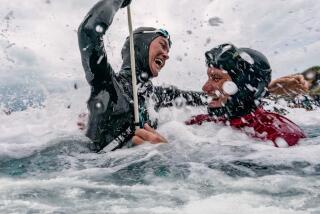‘One More Breath’ : A Device Called Spare Air Saves Navy Pilots Trapped Underwater
- Share via
When their Navy helicopter lost power and plunged into the Persian Gulf, Lt. Greg LaFave and Petty Officer 3rd Class Francis (Skip) Garcia were pinned in their seats as the cockpit quickly filled with water.
Each man reached into his vest, pulled out a small canister, placed the mouthpiece to his lips and began breathing. The compressed air gave them enough time to free themselves from the wreckage and swim to safety.
LaFave and Garcia credit their survival to Spare Air, a product made in Huntington Beach by Submersible Systems, which originally marketed its miniature air tanks to underwater divers and began selling to the Navy last year.
LaFave and Garcia were trained to use Spare Air only a week before they were sent on an extended mission in the Persian Gulf last summer.
The 2-pound, 12-inch-long device fits inside a survival vest and provides oxygen for two to four minutes.
“As soon as I hit, I knew I was going to die,” Garcia said. “I followed my instincts for survival and grabbed for the tank. It gave me the air I needed, and I was able to get out of the trap I was in and get to the surface.”
LaFave said that because of that accident alone, the Navy considers its $1.3-million purchase of 8,200 Spare Air canisters to be money well spent. “The Navy spends almost that much to train one naval aviator,” he said.
“It’s an absolutely wonderful product,” said Joe Taussig, the Navy’s assistant deputy undersecretary for safety and survivability. In an interview from his Washington office, Taussig credited Spare Air, called the Helicopter Emergency Escape Device by the military, with saving the lives of LaFave, Garcia and at least two other men involved in other accidents.
In the past year, the Navy has trained more than 8,000 of its aviators to use HEED canisters, and it plans to buy more of the devices, said George Gillespie, a Navy senior project engineer for HEED in Warminster, Pa.
Submersible Systems hasn’t convinced other branches of the military to start buying the canisters. But president Larry Williamson said prospects have been boosted by the experience of Garcia and LaFave, who recently spent several days telling their story to Pentagon officials.
On Thursday, Williamson brought the two men to Submersible Systems headquarters “for a get-acquainted session with our employees.” In addition, Garcia and LaFave recalled their harrowing experience for reporters.
Williamson, a diver and former aircraft parts maker, said he developed Spare Air after a near-fatal mishap in 1974. Williamson was diving for lobster and ran out of air at a depth of 140 feet.
“I thought, if only I had one more breath of air,” Williamson said. “But I couldn’t get it. I blacked out and floated to the surface. Then I started at work to develop Spare Air.”
Williamson sold his first batch of 100 Spare Air canisters to diving instructors in 1979. The canisters went on sale in diving shops a year later.
The Navy approached Williamson in 1983 after it learned that Marine helicopter crews in El Toro were buying Spare Air canisters with their own money.
Williamson said divers are still the company’s biggest market, with about 600 canisters sold each month at a suggested retail price of $195 each. For its 1988 fiscal year, which ended March 31, Submersible Systems recorded $3 million in sales from the canisters, its only product.
More to Read
Sign up for Essential California
The most important California stories and recommendations in your inbox every morning.
You may occasionally receive promotional content from the Los Angeles Times.












